
Sunday, December 23, 2007
Family Time

Friday, December 21, 2007
The Nativity
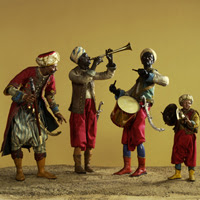
Tuesday, December 11, 2007
Monday, December 10, 2007
Things we love about Advent....
...listening to music for the season such as the above posted Carols by Benjamin Britten.
...lighting Advent candles each Sunday prior to our evening meal. Included in our candle lighting are short readings from the Bible and family prayers.
...making paper chains to helps us count the days--purple loops for Advent (a pink one for the third Sunday of joy), white for the 12 days of Christmas and green or gold for Epiphany. We rip the loops off the chain as each day passes to help the little ones “see” the passing of time.
...praying for the people that we receive greeting cards from each day.
...reading--this year in particular we are enjoying the Advent blog by Jan Richardson. The rich artwork and text that is thought provoking and inspirational.
Tuesday, December 04, 2007
Just read...

Wednesday, November 28, 2007
Tuesday, November 27, 2007
A Visit to the Art Museum
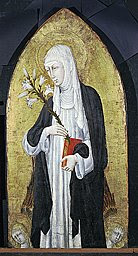
This past weekend I took pleasure in my inaugural visit to Harvard’s Fogg Art Museum in Cambridge, Mass. This museum, which opened to the public in 1895, is Harvard's oldest art museum. Around its enchanting Italian Renaissance courtyard are galleries illustrating the history of Western art from the Middle Ages to the present. The galleries particularly strong in Italian early Renaissance are a great reminder of how religious and liturgical symbols have been incorporated into visual art for centuries. I found the tempra and gold painting of Saint Catherine of Siena by Giovanni de Paola (as seen at left) particularly charming. History knows Catherine Benincasa as the persuasive mediator who negotiated peace between Florence and the papacy. In this portrait, St. Catherine of Siena appears with a sprig of lilies as a symbol of peace, and is wearing the black-and-white vestments of the Sisters of Penance of St. Dominic. Paolo’s graceful approach to Catherine of Siena is accentuated by her elongated figure.
The seasons ahead of Advent and Christmas can be so busy. I recommend you take time to pause and enjoy an art exhibit. There is something very theraputic about walking through the quiet of an art gallery, meditating on, contemplating about or simply enjoying what you see.
Need a gift idea? Enrich a life with the gift of an art museum membership!
Wednesday, November 21, 2007
Preparing for Christ the King Sunday
Monday, November 19, 2007
Thanksgiving
 Here in the United States we are preparing to celebrate Thanksgiving. At Carrot Top Studio we love this holiday because it is not terribly commercial. We can simply take the time to be reverent for the gifts of the earth at this harvest festival. Interestingly our American commemoration of the Pilgrim's feast might be a carry over from the European tradition of St. Martin’s Day which celebrates the end of the agrarian year and the beginning of the harvest.
Here in the United States we are preparing to celebrate Thanksgiving. At Carrot Top Studio we love this holiday because it is not terribly commercial. We can simply take the time to be reverent for the gifts of the earth at this harvest festival. Interestingly our American commemoration of the Pilgrim's feast might be a carry over from the European tradition of St. Martin’s Day which celebrates the end of the agrarian year and the beginning of the harvest.Many faith communities gather on Thanksgiving Eve or Thanksgiving morn to worship. In addition to worship banners and minister’s stoles that represent the colors of a fall harvest, churches might enjoy the use of a cross created out of sheaves of wheat and offertory processions that include food items that can be distributed to those in need. Our home congregation includes the giving of five pieces of corn to each family. We take them home and place them on our table as a visual reminder of the hardships the Pilgrims endured. The story has been handed down that this faithful community of Pilgrims was able to be thankful to their Lord even on days when they only had five pieces of corn to eat.
I’ll close by sharing a favorite recipe that usually graces our Thanksgiving table:
And as Ralph Waldo Emerson said:
For each new morning with its light,
For rest and shelter of the night,
For health and food,
For love and friends,
For everything Thy goodness sends.
Thank you, Amen.
Wednesday, November 14, 2007
Life of the Mill Girls
I think we can easily find inspiration in the story of the mill girls who went to work to earn money for their struggling farm families, tolerated work conditions that did not promote a joyful environment, yet diligently went to church, loved to read and appreciated the arts.
Thursday, November 08, 2007
For Your Bookshelf
This makes me think of the history of Christian worship and how it is immersed in symbolism, beginning with the symbols from the Jewish scriptures such as the rainbow God gave Noah. Until modern times literacy was limited therefore worship depended upon signs and symbols to remind and teach and aid us with the mystery of God. Signs and symbols still serve this purpose today.

A book I often turn to while researching the design of minister’s stoles or worship banners is Worship Without Words by Patrica Klein. This little guide is a very helpful explanation of the liturgical calendar and the signs, symbols, gestures, vestments and architectural elements that accompany liturgy. You may also enjoy it for your bookshelf.
Tuesday, November 06, 2007
Banner Commissions
At Carrot Top Studio we enjoy the challenge of making banners for a specific setting. That is why we don't carry ready made banners. We think it's important that the color, size, and visual message accentuate the existing architecture and environment.
Above is our latest commission. It is a set of seven banners for Advent/Christmas that focus on God's messengers, the angels. The narrow banners are embellished with symbols of Mary: the rose and the fleur-de-lis (a stylized lily). The center banner uses the symbol of a Natal cross which is shaped like a star. This reminds us of the story of Jesus' birth and the foretold purpose of his birth. The decorative flower borders are created using the Glastonbury thorn plant. According to legend it budded from the staff planted by Joseph of Arimethea when he took refuge in Glastonbury. Because it blooms during the Christmas season it has become a symbol of the Nativity.
And here's a glimpse of the process it took to get a finished product.
Thursday, November 01, 2007
All Saints Day
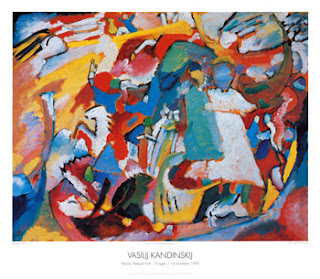
The above is All Saints Day as interpreted by William Kandinsky, an oil painting from 1911. It does not represent the exterior world but rather expresses inner feelings of the human soul.
Amen.
©2001 Nathan Nettleton LaughingBird.net
Monday, October 29, 2007
Walking A Labyrinth
--Saint Augustine
A labyrinth is an ancient symbol that relates to wholeness. It combines the imagery of the circle and the spiral into a meandering but purposeful path. The labyrinth represents a journey to our own center and back again out into the world. Labyrinths have long been used as meditation and prayer tools.
Walking a labyrinth is a right brain task. It involves perception, creativity, and imagery. With a maze many choices must be made and an active mind is needed to solve the problem of finding the center. With a labyrinth there is only one choice to be made. The choice is to enter or not. A more passive, receptive mindset is needed. The choice is whether or not to walk a spiritual path.
I am a right brain person and I have the need to move. Walking a labyrinth is something I crave and I have had very moving moments while using one as a tool for prayer. I love the openness of a time on the labyrinth—it accepts you for whatever age you are, where you are in your faith, what you look like, or whether you needing to move mountains or molehills.
If you want to learn more you will certainly enjoy Walking A Sacred Path by Dr. Lauren Artress. She explores the historical origins of the labyrinth and shares the discoveries of modern-day seekers. If you question the potential of a labyrinth this book will inspire you to try a walk to quiet your mind and open your soul.
To find a labyrinth near you click here.
Saturday, October 27, 2007
A Fine Discussion With Wise Women

This week I had the delightful opportunity of visiting a local retirement community to speak about how color and symbols apply to the seasons of the liturgical church year. We looked at symbols in stoles and worship banners that had specific meaning; like the Alpha and Omega. Symbols like this require previous knowledge or education to understand. Other symbols seem obvious but can have different meaning to different people. We discussed the example of fire. Knowing that we were focusing on worship some of the participants immediately chimed in that fire was a symbol for Pentecost, but upon reflection we also came up with destruction (like the terrible fires currently raging in California), joy (like the flame of a birthday candle, and warmth (like a lit fireplace on a cold winter’s night).
There are also times when symbols rely upon the interpretation of the viewer. We looked at one of Carrot Top Studio’s stoles for Lent that is just an arrangement of purples. The somberness, depth of color and the arrangement allowed us to reflect upon feelings and emotions that we move through during the penitential time of Lent. These women, in their wiser years of their lives, were in agreement that congregations and those in leadership could do more to educate about the visual components of our faith. Human insight, both spiritual and visual, can be expanded and be a significant step in our journey toward a deeper relationship with God.
Tuesday, October 23, 2007
Praise the Lord. Praise God in his sanctuary; praise him in his mighty heavens.
Praise him for his acts of power; praise him for his surpassing greatness.
Praise him with the sounding of the trumpet, praise him for with the harp and lyre,
praise him with tambourine and dancing,
praise him with the strings and flute,
praise him with the clash of cymbals, praise him with resounding cymbals.
Let everything that has breathe praise the Lord. Praise the Lord.
Listen to John Rutter's setting of these words to music while viewing St. Paul's Cathedral, London.
What a magnificent worship space, with so many visual components--rich in color, symbols and art!
Monday, October 15, 2007
Art: A Gift From God

- Arrange museum trips to teach Bible study and Sunday School groups to look theologically at art. For example, how would a study of the Exodus story inform and critique an exhibit of American art of the Old West? You might even call the museum ahead of time to arrange for a docent to collaborate with you in your exploration.
- Set aside part of your church building as a gallery for changing exhibitions of work by artist in the congregation, community or a local college.
- Invite members and friends to bring a brown bag lunch to an “Art lunch” and 30 minute program. Food, fellowship and half-an-hour on Leonardo da Vinci’s Last Supper or The Gleaners by Millet would make for a meaningful workday break.
- Invite interested persons to gather each week to hear the text for the upcoming Sunday sermon and respond to it creatively, as a way of beginning their preparation for worship. If the hymns coordinate with the sermon text or the celebration that Sunday (you’d think they always should, wouldn’t you) add another dimension to the creative response by playing the music in the background as you work.
- Plan a year with the Bible—in art. How have the stories of our faith been painted, drawn, sculpted, built? Spend a year studying art through the Bible and the Bible through art.
- Establish a one-year Artist-in-Residence program, so that your congregation, or a group of congregations, experiences the gifts and creative opportunities of artists working in a variety of media.
God and art are intrinsically connected and we celebrate that truth together. We must encourage the visual arts in the life of the church today!
Monday, October 08, 2007
Columbus Day
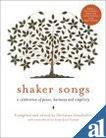 Today, Americans celebrate Columbus Day, a holiday celebrating the arrival of Christopher Columbus to the Americas.
Today, Americans celebrate Columbus Day, a holiday celebrating the arrival of Christopher Columbus to the Americas.Saturday, September 29, 2007
A Knock at the Door

For example, though he had walked through the same door countless times before, Bishop David A. Zubik could enter St. Paul Cathedral in Oakland on Thursday night only after knocking. Pondering this symbolic act that was foreign to me, I could think of several bits of Biblical references that might have inspired the tradition. First, to come to mind was the scripture from Matthew that says, "Ask and it will be given to you; seek and you will find; knock and the door will be opened to you. For everyone who asks receives; he who seeks finds; and to him who knocks, the door will be opened.” Also, Rev. 3:20, “Here I am! I stand at the door and knock. If anyone hears my voice and opens the door, I will come in and eat with him, and he with me.” The messages of these passages to persist in finding God and while also leaving the door to our hearts consistently open to God (personally and corporately) are ones we probably couldn’t hear often enough.
Sunday, September 23, 2007
Our newest banners
Friday, September 21, 2007
Inventory
Do you take inventory at your church? We can think of several
reasons why you might take inventory…from the serious to the crazy!
There is of course the spiritual gifts inventory. Why should we take one of these inventories? Since there is a limit on the time we can serve, we need to look for maximum effectiveness. Structuring our ministries around our giftedness will help us do that. Knowing where we are spiritually gifted will help us know where to put our focus, energy, and time. It will show us where we should plug into ministry.
The Barna group (their goal is to facilitate spiritual transformation) offers another type of inventory. It is a self-administered survey that church leaders can complete to evaluate how the habits of their church compare to the habits of the nation’s most effective churches. This might first occur to you as useless information but it can be a wonderful launch pad for discussion amongst your leadership.
When I was thinking about inventory I recalled the year my husband had the job of taking the inventory of the church silverware, plates, glasses etc. for a Williamsburg Christmas dinner. Thank goodness he has a jolly disposition because this type of inventory can be tedious!
Have you ever had to inventory your church membership records? You look for those that no longer live in the area or have moved to another church or aren’t worshiping anymore. This type of inventory certainly has be taken with great care so as not to offend anyone. You would still welcome someone that hasn’t graced your doorstep after many years astray wouldn’t you?
Advent is one of our busiest seasons and it’s only ten weeks away! So, Carrot Top Studio took an inventory this week. Now we’re sure of what we have available in stock and think we have a plan for filling in the holes. Our clients are always full of good ideas…any thoughts or suggestions?
Taking inventory has allowed our new old stock (NOS for short!) to be offered for sale on eBay this week (listings begin 9/20 and 9/22). Most of these designs will not be produced any more and we hope you will take advantage of the bargains!
Someone once said, “if it is important to you, it is worth documenting. If you don't feel it is worth documenting, then take another look at it.” Does this apply to church inventories? I leave you with that to chew on.
Tuesday, September 18, 2007
Color!
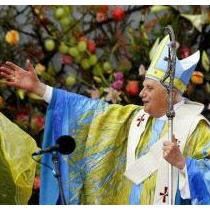
I am not Catholic so it has been interesting to learn that when the Pope visits a venue outside of the Vatican a Master of Ceremonies dictates the outer vestments worn by the Pope and others involved in worship.
It was delightful to stumble upon this photograph of the Pope recently in Austria. What a splash of color! I don't know what the Pope's message was while in this moment, but when I look at the vestments I feel joy, peace, rebirth and growth. Personally I yearn for the traditional colors of the liturgical calendar to mark the rhythm of worship, but during Ordinary Time I find it energizing and stimulating to see the use of other colors. I appreciate this freedom and spontaneity.
Interestingly a brief examination of the use of liturgical colors throughout church history quickly leads to the conclusion that no pattern of liturgical color is "correct" in and of itself. For over a thousand years the church gave little attention to the use of color. White vestments predominated. It was not until the twelfth century that schemes assiging colors to seasons and festivals began to appear in wealthier cathedrals, abbeys, and churches. We can appreciate our history while striving to continue to worship the Almighty Lord in ways that are most fitting for the moment.
*please forgive me if I've bungled any of the facts about the Catholic church. I would appreciate hearing from you if I need to stand corrected.
Monday, September 10, 2007
Poiema
 It wasn't until recently that I started to challenge myself to learn new words and actually try to apply them in speech and writing. I wonder why it took 4+ decades to enjoy this activity? Regardless, I'm pleased to announce that I learned a new word today! I stumbled across an artist who calls her business Poiema. It is pronounced poy'-ay-mah. You probably use this word daily but, because I don't I got caught up in doing a little research.
It wasn't until recently that I started to challenge myself to learn new words and actually try to apply them in speech and writing. I wonder why it took 4+ decades to enjoy this activity? Regardless, I'm pleased to announce that I learned a new word today! I stumbled across an artist who calls her business Poiema. It is pronounced poy'-ay-mah. You probably use this word daily but, because I don't I got caught up in doing a little research. It turns out that Poiema is a Greek word used in the New Testament for handiwork or work of art. It says that we are God’s creation. It is a referenece to Ephesians 2:10: "We are His work. He has made us to belong to Christ Jesus so we can work for Him. He planned that we should do this." He speaks here of grace, and not of nature: therefore if the works are ever so good, we should see what they are, and know that they are that way because of grace.
How exciting that each person is a beautiful gift. Everyone is welcome and their gifts are encouraged. Every single one of us is a masterpiece. So be it!
*artwork is the Vitruviun Man by Leonardo da Vinci. A little known fact...The Vitruvian Man is actually named for the man who created him, the Roman architect Vitruvius. Vitruvius, a proponent of the Sacred Geometry of Pythagoras, designed temples based on the proportions of the human body, believing them to be perfect. This perfection, wrote Vitruvius, was due to the fact that the extended limbs of a perfectly proportioned human fit into both the circle and the square.
Thursday, August 30, 2007
Bats

I enjoy seeing the bats circle the tops of the pine trees at night but really didn't know how to handle this scared, little creature inside....especially as my daughter turned white because she was petrified.
After an animal control agent (I kid you not!) took care of the situation I had a jolt of a memory of a pastor in our church many years ago. Reverend was very tall and wore a black robe while preaching. He pronounced the benediction each Sunday by raising only one arm. We came to learn that when the pastor was young he first delivered a benediction with his wife-to-be in the pews whom immediately erupted in fits of silent laughter. It turns out that between the man's stature and the big black robe all his betrothed could think of, while he raised both arms at the end of worship, was that he just looked like a big old bat. Hence the forty year tradition with this wonderful man of only using one arm to deliver a benediction!
At Carrot Top Studio we work at and blog about the visual in the church today. Visual components such as banners and stoles certainly aren't created to make the congregation laugh. But, recalling our former pastor's story does make me sensitive to the fact that the visual can appear differently from different perspectives! How about you...any visuals that didn't work despite your good intentions in your church? I hope the reaction was laughter and nothing much worse. I'll sign off so I can make sure the screens and doors are secure so there will be no more unexpected guests in the studio today!
Tuesday, August 28, 2007
Beauty and Art at the Glen Workshop
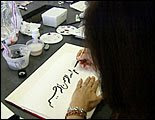
Do you know about the Image and the Glen Workshop? They were featured this past weekend on a broadcast of Religion and Ethics Newsweekly, a national public television program produced by WNET Television in New York. The segment was recorded at the recent Glen Workshop, which was centered on the theme—“God of the Desert: Judaism, Christianity, and Islam through the Prism of Art.” Its purpose was to challenge Christian artists to discover how beauty and art might enable a better understanding of other religious traditions that trace their lineage back to Abraham.
The Religion and Ethics Newsweekly a national television program saw Image's mission and program as newsworthy and aired a segment about the Glen Workshop this past weekend.
The program will remain up on the RENW home page all week. To go to the Religion and Ethics Newsweekly home page, click here.
Wednesday, August 22, 2007
Inspiration From the Gee's Bend Quilts
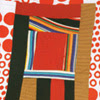
Last weekend found the Carrot Top Studio staff in Baltimore to see the Gee’s Bend quilt exhibit at the lovely Walters Art Museum. The exhibition explored the impact of environment and traditional quilting techniques, and examined the structural patterns that appear to form the foundation of Gee's Bend quilt making. The quilts, whose patterns have been handed down through generations, display bold colors and an improvisational style that is reminiscent of 20th-century minimalist art.
Artistically, the distinctive and bold quilting style reminded me that simple is often better. The power and beauty of these quilts often comes from basic shapes in solid planes and subtle color choices. The quilts can be appreciated without the distractions of composition, theme and other elements of traditional quilting. The work has been stripped to what is essential.
The powerful American artistic quilting tradition of the women from Gee's Bend has been passed down through at least six generations to the present. The faith traditions of this community are just as strong. I don’t know how they have passed on their faith traditions but, I wonder if some of the following has been part of the families lives at Gee's Bend:
- bringing faith into the family's daily life...noticing God's fingerprint throughout the day.
- letting children experience the richness of worship...the sights, the smells, the sounds, the rhythm of the liturgy.
- teaching children the language of faith...the symbols, images, stories and songs.
The handing down of statements, beliefs, legends, customs, information, from generation to generation, especially by word of mouth or by practice is important. Today I am thankful for my family and others like the women of Gee's Bend who have gone before me.
We hope you’re inspired by the photo which is of “Housetop Variations” by Loretta Pettway, 2003.
Friday, August 10, 2007
Mystery Stole Giveaway
You desire:
- stoles that tell stories
- more Celtic knot work designs on stoles
- additional nature designs
- a design with reformation symbols
- stoles with symbols depicting a labyrinth
- the healing hand of God depicted on stoles (we actually have had several limited editions of healing stoles and they always sell out--you'll see more of this theme!)
- a line of lower priced stoles (if you don’t know about it you should check out our eBay items for weekly bargains.
You like:
- our price points
- our commitment to ship within 24 hrs.
- the new line of stoles with the hand dyed silk from the small business in Haiti. We now have four designs in this series and we’re enjoying giving 50% of each sale back to the LaCroix Mission in Haiti.
Several clients suggested we expand our advertising. This is where we could use your help. If you have a publication, webring or other network that we could advertise in we’d love to hear your suggestion. Please email jenny.gallo@carrottopstudio.com or make comment to this post.
And now, the drum roll please….the winner of the MYSTERY STOLE is a pastor in Massachusetts and she has been notified via email. We have shipped this stole (as seen below). It was designed with the universal message of peace. Ironically the winner has the word “peace” in her email address!
Monday, August 06, 2007
Coffee Rituals

As one of the most heavily traded commodities in the world, coffee is a direct link between our community and farming communities in Latin America, Africa and Asia. We love purchasing our coffee from Equal Exchange (http://www.equalexchange.com/). By paying a fair price, working with democratic cooperatives, offering affordable credit and supporting sustainable agriculture, Equal Exchange helps farmers to build better lives for themselves and their families.
It’s finely hot and humid outside the studio. About 3:00 in the afternoon you can find us recharging for the rest of the day with a decaf Vietnamese Iced Coffee. We hope you’ll enjoy our version as follows.
Vietnamese Iced Coffee
2-3 teaspoons sweetened condensed milk
1 c. bold (such as French roast) coffee
Ice cubes, as needed
Put the condensed milk into a coffee cup. Stir to dissolve milk. Pour this mixture over ice in a beautiful glass and stir briskly with a long handled spoon, making an agreeable clatter with the ice cubes to chill the coffee.
Now go pour yourself a refreshing drink and if you haven’t entered the contest to win the Mystery Stole do it now! The clock is ticking! The winning entry will be drawn on August 10th and will be announced on the Carrot Top Studio blog! Go to
Monday, July 30, 2007
Artistic Expressions
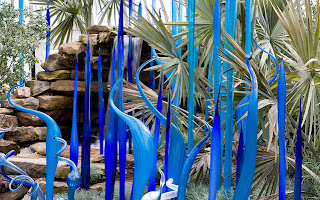
Phipps describes this exhibit…“Right here in our lush and inspiring gardens, Chihuly has planted an exhibit of his wild and wonderful creations -- and the result is simply breathtaking. Known for his flamboyant colors, monumental sculptures and outdoor displays, Chihuly is also famous for his creative collaborations. Inspired by our Victorian glasshouse – one of the oldest in North America, this pioneer in the use of glass has joined with our horticulturalists and landscape designers to create a dazzling fusion of art and nature.” The show lives up to this description and much more.
I don’t think I’ve ever had a presentation of art touch me the way this show did. One of the thoughts that continually ran through my head was how Chihuly was able to use his glass art to supplement the already superb environment of the gardens. Even with the exquisite coloring of the glass the art always seemed to mingle happily with the environment. The art did not scream for attention. The plants were not shouting out because they were being ignored. The surrounding architecture was like the perfect packaging. This concept relates to our worship spaces. When wearing stoles, hanging worship banners, or even adding a flower arrangement to the chancel I believe it should only be done to enhance the worship that will occur in the space. These artistic expressions are best when they awaken us to God’s presence and not call attention to themselves. I appreciate how the Presbyterian Church phrases this concept in their Book of Order; “artistic expressions should evoke, edify, enhance, and expand worshipers’ consciousness of the reality and the grace of God.”
If you are in the Pittsburgh, PA area prior to this exhibit closing on November 11, 2007 you would be amiss not to treat yourself to the experience of a visit to the Chihuly exhibit at Phipps. In the meantime think about the space you worship in and encourage artists in their offerings. Lastly, see if you recognize some lines and shapes that echo the work of Chihuly at Phipps in new stoles designs at Carrot Top Studio!
Tuesday, July 24, 2007
Support a Womens Small Business in Haiti
Our faith community, Westminster Presbyterian (http://www.westminster-church.org) in Pittsburgh, PA has a relationship with the LaCroix New Testament Mission in Haiti. Recently, friends visited Haiti and taught a small group of young women from the mission to hand-paint silk. The group is known as La Femme de LaCroix (The Women of the Cross). They have now learned how to paint, process, package, and keep records for the project. The goal is to provide training for the girls, who also get tuition credit for the silk they produce. The mission receives the entire profit from the sale of the scarves made from this silk. We have purchased some of the exciting hand dyed silk to encourage the women of LaCroix in their small business and to include it in the design of a series of stoles for purchase through the Carrot Top Studio website.
Fifty percent of the sale of each stole will be given to support the ministry to this Haitian community to help it continue to grow to become healthy and strong. You may purchase one at CarrotTopStudio.com (http://http://mysite.verizon.net/vzeoro2y/id72.html)
Friday, July 20, 2007
Something's Underfoot

I have been thinking about these types of textiles while savoring the novel The Blood of Flowers by Anita Amirrezvani. The story takes place in 17th-century Persia where a 14-year-old woman believes she will be married within the year. But when her beloved father dies, she and her mother find themselves alone and without a dowry. With nowhere else to go, they are forced to sell the brilliant turquoise rug the young woman has woven to pay for their journey to Isfahan, where they will work as servants for her uncle, a rich rug designer in the court of the legendary Shah Abbas the Great. She learns the carpet trade, blossoming as a clever designer and talented knotter. This captivating tale is interwoven with traditional Iranian folktales, as well as fascinating details of the art of the Persian rug.
Amirrezvani’s piece of literature, based on historical fact, is rich in detail of symbols and colors important to the religion of her characters. Time and time again in history we see examples of how the visual components of our faith are important. Another example is the photo in this blog that shows details of a rather unusual "Daghestan" prayer rug. It’s interesting to note that the cross shapes (as familiar to Christians) abound in this piece - even in the border. I am not an expert but one researcher of this rug wonders if it had been woven by Armenian Christians. It is not difficult to imagine the entire piece as a work of Christian faith.
Sunday, July 15, 2007
Why Wear A Stole?

All this fun brainstorming may find you asking yourself why pastors even wear stoles. We’ve learned several stories. Stoles first might have originated as a practicality. It’s believed they were something upon which to wipe one’s hands after receiving the offerings of the people at a time in the early church when offerings of produce, other food stuffs and various animal products as well as financial offerings were given.
Secondly, in the 10th century, priests were commanded to wear stoles as a badge of their calling, especially when traveling. They may even have had little bells on the ends so people would know when they were approaching.
Lastly, we think symbolically of a stole as a yoke. This reminds us of Matthew 11:28-30, “Come to Me, all who are weary and heavy-laden, and I will give you rest. Take My yoke upon you and learn from Me, for I am gentle and humble in heart, and you will find rest for your souls. My yoke is easy and My burden in light”.
What do you think? Does any of this history of pastor's stoles or brainstorming of new ideas grab you? If you’d like to share any ideas send us an email or better yet share the idea when you enter to win the free "Mystery Stole" at Carrot Top Studio. Go to
Tuesday, July 10, 2007
Pueblo Style Cross
In Christendom the cross reminds Christians of God's act of love and atonement in Christ's sacrifice at Calvary - "the Lamb of God who takes away the sin of the world." The cross also reminds Christians of Jesus' victory over sin and death, since it is believed that through His death and resurrection He conquered death itself.
The cross is often depicted in different shapes and sizes and in many different styles. The Pueblo style cross as seen on the pictured stole is based on one that was found among the Pueblo people, groups of Native Americans living in the Southwest. The crosses usually have a plain design and are made of silver. When Spaniards arrived in the Southwest and encountered the native peoples in the early sixtennth century, they erected tall crosses at each village. The Franciscan missionaries taught the Native Americans to revere the crosses. The priests traded or gave ornamental crosses to the people, believing that if the Native Americans wore the crosses, they were accepting the new religon. In most cases the Pueblo peoples had accepted the crosses only as ornaments and not as symbols of the religon associated with them. Over time, many Pueblo people were converted to Christianity, and they personalized the cross design with their own cultural interpretation.
Sunday, July 08, 2007
Creativity
Praise the Lord, I tell myself;
Tuesday, July 03, 2007
Recalling Patriotic Hymns

A favorite, “O Beautiful for Spacious Skies” by Katharine Lee Bates was written when her soul was stirred by the expansive earth below and the spacious skies above while hiking Pikes Peak in Colorado. She wrote, “It was there as I was looking out over the amber skies, that the opening lines of this text formed themselves in my mind.” Reportedly she immediately set to writing the hymn while in Colorado Springs.
I adore hiking the mountains and have had the pleasure of traveling to the top of Pikes Peak so I can relate to Ms. Bates reaction to her experience. There are many other places in this grand world that can provide those “mountain top moments”. I’m proud to be an American but after reading the history of this hymn I also think the wonderfully descriptive words it contains can be supplied for many places on this wonderful planet. Thanks be to the Creator.
Tuesday, June 26, 2007
Living in God's Time
Jesus teaches us through parables about the kingdom of God. For example, he uses the story of the mustard seed which grows into a large shrub. Likewise during Ordinary Time many churches use the color green for their stoles, vestments, and banners as an instructional reminder. Green is the color of growth and we can easily be stirred by nature to examine the multitude of variety there is within the hue and then carry this into the color within our sanctuaries. We are constantly inspired by Jesus's clever ways of teaching and using color and symbols is yet another way we can reach especially those that learn visually.
Additionally, as we grow to understand the kingdom of God I think of the questioning strategies that the Children and Worship (http://www.childrenandworship.org/ ) program uses. They teach the children to “wonder” to facilitate growth. For example:
- I wonder what the kingdom of God looks like in today’s scripture?
- I wonder why Jesus told this story?
- I wonder how I would have to change to live as Jesus tells us?
- I wonder what I can do this week to participate in the kingdom of God?
In the midst of this Oridnary Time enjoy the numerous greens, take time to wonder, and be encouraged to grow and lead others to do the same.
*The pictured Mustard Seed stole will be available on eBay (http://search.ebay.com/_W0QQsassZcarrottopstudioQQhtZ-1QQfrppZ50QQfsopZ1QQfsooZ1QQrdZ0?) beginning 6/28.
If you like these thoughts you may enjoy Living in God’s Time, by Margaret McMillan Persky.
Wednesday, June 06, 2007
Children and Worship
For parents:
It is hard to sit still for long. God knows this and so do we.
Growing up isn’t always easy, but it is well worth the effort.
For the congregation:
Greet the children around you.
Pass the children the offering plate, rather than over their head.
When children give visible worship leadership, respond to them as worship leaders—not as performers!
Always laugh with children, not at them.
Invite a family with children to sit with you.
Be understanding when parents need to take younger children out and then return to worship.
Remember the promise we make at the baptism of the children among us!
For the leadership:
In Children in the Worshiping Community by David Ng and Virginia Thomas it is suggested to read aloud Romans, chapter 12 with a group of children. Are these children not members of the body of Christ, with differing gifts? Can they not show faith and serve and teach and show mercy? Children can love, show honor, be aglow with the Spirit, rejoice in hope, be patient in tribulation and constant in prayer. The church would not be whole without children.
Children like adults respond to visual stimulation. Think about the vestments, paraments, banners, and bulletin covers your congregation uses. Are the symbols and colors relevant to support the worship? Do they change often enough so the congregation will continue to take notice?
Celebrate, embrace and learn from the children in your midst! Jesus welcomed them, so can we.
Wednesday, May 30, 2007
Ordinary Time Ingenuity
Give a flower~Eat lunch with someone new~Listen with your heart~Visit a sick friend~Clean a neighbor's walk~Offer a hug~Give an unexpected gift~Make a new friend~Say "hello"~Call a lonely person~Open a door~Help carry a load~Plant a tree~Pass a kindness on~Buy someone's meal~Cheer up a friend~Thank a teacher~Give blood~Read to a child~Do one kind act every day~Leave a thank you note~Offer your seat~Tip generously~Be tolerant~Let another go first~Tutor a student~Give a compliment~Pay the next driver's toll~Lend a hand~Offer a ride~Respect others~Encourage a child~Walk a dog~Do a favor~Forgive mistakes~Drive courteously~Share a smile.
Enjoy living in the midst of Ordinary Time!
Thursday, May 10, 2007
Pentecost
The church is Pentecost.
The Holy Spirit is poured out upon us
And sends us out together
aflame
with new life,
Inheritors of the wealth of God:
Life abundant.
We are liberated from the prisons of pettiness,
jealousy, and greed,
Liberated to be the church.
From Reaching For Rainbows
Wednesday, April 18, 2007
Book Review

PS-Don’t neglect the wonderful creative answer to banners by Nancy Chinn on the cover of this book!
Thursday, March 22, 2007
Rejoice!
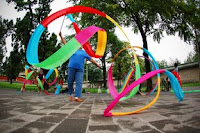
How will your congregation illustrate the joy of the Easter season? It may possibly be through the traditional colors of white and gold. Many will display lilies (see http://mysite.verizon.net/vzeoro2y/id66.html for an explanation of lilies) and spring flowers. Crosses will be draped in white and stoles and worship banners will display butterflies and the Lamb of God. Others will greet Easter morn while worshiping outside. The bona fide rising sun is an awesome visual display that could be part of any liturgical ritual.
What else can we do that is visual in worship for Easter? Involving children is keeping with Christ’s teachings. The young and young at heart would love to show their Easter joy with visual art that includes motion. Make ribbon dancers (directions follow) and let them REJOICE through movement accompanied by the uplifting music of Easter.
Ribbon Dancer
Supplies: 12” long wood dowel at least ¼” in diameter,
1 eye hook,
1 barrel swivel (found where fishing supplies are sold),
3-6’ silk ribbon, approx. 1” wide.
Attach eye hook in end of dowel. Attach barrel swivel to eye hook. Tie ribbon onto barrel swivel. Enjoy the movement of the ribbon by holding the dowel and turning your wrist.
Wednesday, March 07, 2007
Saint Patrick
Saint Patrick is of course one example from history that we can model our lives after. He was a missionary and the foundations of Christianity in Ireland are largely attributed to him. His life included a time in captivity, but he showed faith when he heard God’s call. The seeds that were planted when Patrick learned the Celtic language while in captivity allowed the perfections of God’s holiness to shine through him. By contemplating and honoring saint’s goodness, we come better to know and revere the overawing holiness of God.
Many of us are preparing to celebrate Saint Patrick’s Day. Some will do this with a green beer in hand or a green carnation on the lapel. But you might model your action after St. Patrick who of course focused elsewhere. He said, “May the strength of God pilot us, may the wisdom of God instruct us, may the hand of God protect us, may the word of God direct us. Be always ours this day and for evermore.”





